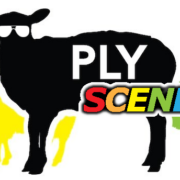Mix Tape for the Modern Urban Spinner
by Andrea Deck
In 2020, we mixed up the fiber festival to become more accessible, more community driven, and more modern than we’d ever been before. Working with social media in new ways, shepherds, dyers, vendors, and spinners alike had to create a new mix of a truly ancient craft and a modern, uber-connected world. Many of us hunkered down from our in-person fiber festivals and started to think about what it would look like to connect digitally.
Come Together (The Beatles)
While the social nature of fiber farming and making beautiful fiber creations is deftly woven into the story, so many of those relationships are based on proximity.
Welcome to the Internet (Bo Burnham)
This transition to the online space was far from new, but many of the most adept at Ravelry and social media were far removed from the production side of the fiber experience. Many small businesses, shepherdesses, and farmers operated entirely in person, selling at small fiber festivals in their area. As you may know, this missing link in the supply chain led to quality wool producers around the world converting beautiful fleeces to fertilizer or trash throughout the pandemic. When Maryland Sheep and Wool, PLYAway and other big national festivals shuttered their physical doors in 2020 to weather the storm, business owners and fiber artists alike flocked to social media. Facebook groups and Ravelry threads were lighting up in new ways to combat isolation and fear but also to ask the very real question “what now?”
Empire State of Mind (Jay-Z)
Living as a City Mouse in a postage stamp of an apartment has a few major drawbacks: price, space, and all my local supplies of yarn or goodies are either very corporate or very expensive. If I was looking for a full fleece or anything that still smelled like a barn, I was headed out to fiber festivals hours from my home. I already had experience scouring the internet for economical resources and shops I’d heard of or seen on festival websites. I was adept at buying hand-dyed yarn from websites older than I was with terrible color photos and worse descriptions, then waiting weeks or months for my squishy mail to arrive.
So by the time the pandemic hit, I was in the right place (already working remotely and adept at finding fiber online) at the right time (my city and work changed dramatically and quickly) to be a part of reimagining the festivals online. I went from the fringe of the fiber community, with no space for sheep or capacity to design new things, to building documents and best practices for transitioning that community online. What lighting were we using for professional social media videos? What network capabilities were needed to live stream? How do you deal with taxes and shipping around the country?
The communal aspect of the craft came to the fore early: join an online festival as a vendor and be welcomed into a league of small businesses learning to survive online. Places like VirtuWool and Wool and Fiber Arts groups offered mentors, weekly check-ins, and volunteers to help run live sales, as well as feedback on your web platform and performance. Need a few hours of professional help? Head to the group to find a contractor who also happens to love wool. Community groups developed codes of conduct, new folks were welcomed by moderators, and excitement buzzed long before and after any individual sale.
As webinars on ad words and stabilizing rural Wi-Fi popped up alongside new online fiber festivals, sales, classes, and more, a whole new audience also emerged. As accessibility into these spaces grew, so did the diversity of both the buyers and sellers. Folks continued to show up: new and older generations of crafters, people facing isolation for a wide variety of reasons, the “fiber curious” who had only bought a ball of yarn at Target. If there is one big takeaway from this crazy time, it’s this: the lowering of all sorts of barriers has made our fiber festivals, and our community, stronger, more creative, and more diverse.
Re-emergence: As we re-emerge, let’s take a look at what we’ve learned and how we’ve connected to create a new mix tape of our favorite tunes. For my personal jams, I’m trying new songs to use my distance from the sheep in the field to develop new tools to engage with the fiber community and using my personal, introverted hobby to connect more broadly across the world.
See You Again (Carrie Underwood)
Return to in person festivals can’t mean an abandonment of the online groups and communities we’ve found so much value in over the past two years. These novel ways to engage in the things we’ve done for centuries is part and parcel of the future and history of fiber craft. My biggest fear is after building infrastructure and community in new online spaces for over two years they (and we) will be abandoned for the in-person meet ups again.
Meet Me Halfway (Kenny Loggins)
How to hybrid? For me, I’m about to embark on a shlep back to my favorite festival, and while I’m so excited to be back in person, I’m also feeling very alone. This is the first festival where not one of my Ravelry or online groups is getting together. The stitch marker swap that has happened for years has fallen apart. It is up to us as artists, community members, festival organizers and attendees, and voices across our fiber community to take the best songs we learned during COVID and keep playing them. The in-person event space has long asked questions about what it means to feel welcomed or to feel like we belong, and there’s a ton we learned as strangers online that we can bring with us! There’s room for all of us and more at these festivals and in our community, because it’s an awesome place to be.

Andrea Deck (@craftondeck) is a spinner, weaver, knitter, and lover of fiber living in the heart of DC with her husband and huge yarn stash. Professionally, she is a community builder specializing in engagement of young adults, couples, and you.
PLY Magazine believes that Black lives matter, as well as LBGTQI+ lives. Those most vulnerable and persecuted in our communities deserve our love and support. Please be good to each other.
Did you know we also have a monthly PLY newsletter? Sign up here!
Did you know we also have a monthly PLY newsletter? Sign up here!






Leave a Reply
Want to join the discussion?Feel free to contribute!